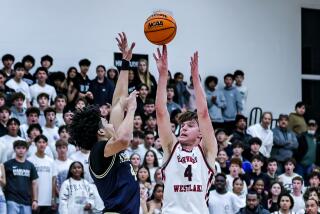The New Division II: More Baseball, More Flexibility
- Share via
NEW ORLEANS — Through the wall of an adjoining room, loud voices could be heard as Division I delegates to the 80th annual NCAA convention battled over new academic guidelines for freshmen.
The debaters, in the main ballroom of a hotel built on the banks of the Mississippi River, had the national spotlight on them.
But away from the sound and the fury, Division II delegates were debating in relative obscurity in the very next room.
For Bob Hiegert, Cal State Northridge men’s athletic director, and Judith Brame, women’s athletic director, the issue on the table was of more immediate importance.
Agenda item No. 101, increasing the maximum number of Division II baseball games from 60 to 80, with not more than 60 in the spring, was considered item No. 1 on the CSUN agenda for New Orleans.
At first, it was declared defeated by a show of hands (actually, a show of paddles. Delegates voted by raising a piece of cardboard cut in the shape of a paddle).
But when a recount was demanded, item No. 101 squeaked through, 74-69.
“We were very concerned about this item,” Hiegert said. “It was approved last year, but inadvertently, through a mistake in the way it was presented, only for Division I. That gave them a recruiting advantage. It really took away from our program.”
How much is too much?
Schools such as Wichita State and San Diego State were playing more than 80 games a year before limits were imposed.
“When they were recruiting kids, they could tell them they had the ability to play 20 to 25 more games a season,” Hiegert said. “That might mean 100 games in their collegiate career. It got to the point where you had to ask whether we were producing students or professional players.
“But I had to ask, how could I justify a kid being out of class that much time? It was getting out of hand.”
CSUN played 56 games last season, plus 20 to 25 in the fall that do not count toward a conference championship.
“We said, let’s come up with numbers that are realistic and sensible and can be in line with economic and academic progress,” Hiegert said.
But there is East and there is West and many observers questioned whether the twain could meet on this matter.
Eastern schools wanted more games in the fall, when their weather is often better than in the spring. The 60-20 formula was finally agreed upon.
Even that proposal, however, ran into strong opposition in New Orleans. One of the problems was a resolution from the NCAA President’s Commission, passed by a special convention last June, which advocated no further increase in the number of athletic contests in any sport.
Despite that, Item 101 finally prevailed. So did the the other major item on the Division II agenda.
A Division II school had been required to have at least two team sports for both men and women. Under an amendment approved Monday, one of those programs may now compete at the Division I level.
It was known as the Portland State amendment.
Isolated in an area devoid of Division II baseball, Portland State moved up to Division I before the rule requiring two team sports in Division II went into effect.
That would have left the Portland school guilty of non-compliance, although the rule went into effect after its program was under way.
While there was genuine sympathy for Portland State’s predicament, Hiegert and Brame believe the new rule might invite trouble.
“This could open the door to abuses in the future,” Hiegert warned. “It might be possible for a Cal State Bakersfield, for example, to now take part in a Division I program. It could dump all its resources into one or two sports and that would be contradictory to the idea of a broad-based program.”
Other items involving the lower divisions at the convention include:
Rejection of an amendment that would have ended the Division III indoor track championship events.
Passage of an amendment requiring Division III schools to have at least two team sports for men and an equal number for women.
Establishment of minimum numbers of contests and participants in all Division III sports.
Rejection of an amendment that would have established a three-year waiting period before a school switching divisions could compete for a championship.
Approval of an amendment allowing a Division II school to petition to be allowed to compete in Division III in a sport if there is a Division III championship in that sport, but none for Division II.
Rejection of an amendment that would have allowed Division I or Division II schools that move down to Division III in football to compete for the championship only after a specified period of time.
Approval in Division II and III of special exceptions to the transfer-residence requirement for junior college students. That amendment was rejected by Division I.
Approval by Division II and III of extensions to the five-year period of eligibility for student-athletes in special cases, such as serious injuries.
Approval of an amendment allowing immediate eligibility for a student transfering to a Division III school if he obtains a written release from his former director of athletics.
Approval by Division I, but rejection by Division II, of an amendment that limits the number of softball tournaments to 10 in an academic year, and specifies that each day of a tournament shall count as only one game played, regardless of the actual number of games played on that day. That protects teams from going over 60, the maximum number of games permitted in a season.
More to Read
Go beyond the scoreboard
Get the latest on L.A.'s teams in the daily Sports Report newsletter.
You may occasionally receive promotional content from the Los Angeles Times.






